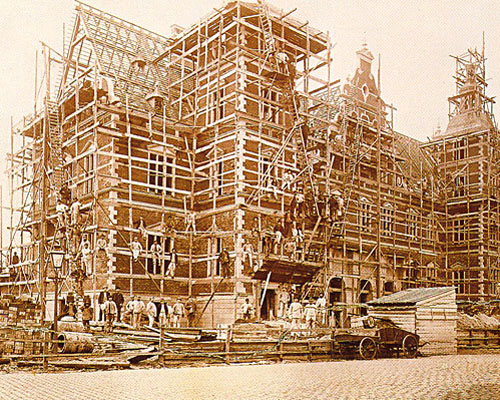| Historicisme

| | 1800-tallets hektiske byggeaktivitet, bl.a. af offentlige bygninger, blev, på det nærmeste, en udstilling af tidligere tiders arkitektur. Der er tale om direkte efterligninger, imitationer og stilsammenblandninger. Helsingør Station fra 1891 er således opført i renæssanceimitation. Fænomenet kaldes for: Historicisme. |
Historicisme og nationalromantik
Den fremherskende arkitektoniske retning i 1800-tallet er den såkaldte historicisme, hvor arkitektur og bygningsrestauration låner stilelementer fra forskellige tidligere perioder i forsøg på at finde et tidssvarende formsprog. I anden halvdel af 1800-tallet udvikles en retning med tilknytning til de skandinavistiske og nationalromantiske strømninger. Denne stilart henviser til den fælles fortid, vikingetiden, men har også tæt forbindelse til tidens skønvirkestil.
Marienlyst Badehotels nybygning fra 1897 er, især med det karakteristiske tårn der forsvinder engang i 1930erne, opført i den for tiden karakteristiske byggestil med udbredt anvendelse af træværk, til bl.a. gavlkonstruktioner og udhæng, og ornamentale stiltræk fra vikingetiden. Den genfindes på Aalsgaarde Badehotel, Dragør Badehotel og de første egentlige sommerhusbyggerier i Ålsgårde og Hornbæk fra omkring århundredeskiftet.
Tager man til Falsterbo i Skåne genfinder man stilarten og i Arild og Ramlösa findes også eksempler på vikingestilen og senromantiske trækonstruktioner. Desuden kan nævnes en lang række offentlige bygninger. Den gamle færgestation i Helsingborg er godt eksempel, og Østerport Station og andre togstationer på kystbanen er en ren opvisning i denne stilart.

Marienlyst Hotel | 
Sommerhus i Hornbæk | 
Helsingborgs færgeterminal | 
Villa Svea | 
Villa Dana |

Klampenborg Station | 
Ålsgårde Badehotel | 
Vikingestil Arild | 
Vikingehus | 
Bjælkehus |

Østerport Station | 
Tag og spir |
Helsingørs nye Rådhus
I 1855 stod Helsingørs nye Rådhus færdigt. Forud var gået en nok så hidsig debat, hvad der ikke var eller er unormalt for byen, når større ændringer skal foretages. Anledningen til nybyggeriet var i første omgang, at det gamle rådhus -fra 1500 tallet- stod for en nødvendig modernisering af arresten.
Undervejs blev det konstateret, at en sådan ombygning krævede, at man rev hele det gamle rådhus ned. Debatten gik da bl.a. på om man så ikke burde opføre det nye rådhus på Axeltorv.
Det endte dog med, at man, med de fra nutiden kendte budgetoverskridelser, opførte det nye rådhus i nygotisk stil, hvor det gamle havde ligget.
Hvis man i 1854/55 havde vidst, at Sundtolden forsvandt blot to år efter, da havde byen nok ikke fået et så imponerende byggeri.

Helsingør Rådhus 1830 | 
Helsingør Rådhus 1855 | 
Helsingør Rådhus 2007 |
Helsingør Station
Et godt eksempel på historicismen er Helsingør Station. Stationen blev opført i 1890/91 og hovedtanken var, at den skulle matche Kronborgs majestætiske fornemhed. Besøgende til byen skulle imponeres. Danmarks førende jernbanearkitekt P.C. Holsøe skitserede hovedideen, og detaljerne blev udformet af arkitekten fra Københavns Hovedbanegård, Henrik Wench.
Banegården, som den blev kaldt, blev en stilimitation af den renæssancestil, som blev kaldt ”Christian 4. stil”. Museumschefen for Helsingør Bymuseum, Kenno Pedersen, betragter bygningen som ”Landets flotteste jernbanebygning”. I en publikation med samme titel skriver han (1991)
”Den er karakteriseret af røde teglstensmure med firkantede vinduesindfatninger med trekantfrontoner og vandrette murbånd af sandsten. Hertil kommer de smukt svungne gavle og tårne med grønne kobberspir samt den imponerede indgangsportal med de blanke marmorsøjler”

Helsingør Banegård 1891 | 
Helsingør Station
2007 |
Helsingør Toldkammer
I 1891 erstattede dette toldkammer et mindre toldkammer fra 1700-tallet. Arkitekten var den kendte arkitekt Johan Daniel Herholdt (1818 - 1902). Herholdts interesse for norditalienske renaissancepaladser præger en stor del af hans arbejder og således også Helsingørs Toldkammer.
Museumsinspektør Lars Bjørn Madsen fra Helsingør Bymuseum betegner i et af sine værker (1991) helhedindtrykket således:
"Det første indtryk man får af Helsingør Toldkammer, er dens umiddelbart prunkløse ydre, især sammenlignet med jernbanestationen og posthuset(...)

Helsingør Toldkammer |
Restaurationsdillen
Et af de områder der kommer i fokus for den praktiske skandinavisme er restaureringen af en lang række kulturminder, hovedsagelig kirker og herregårde i det skånske område. Omkring midten af 1800-tallet indtræder en restaurationsdille som rammer store dele af de skånske herregårde og omskaber dem fra gedigne renæssancebyggerier til poleret nygotik og fransk chateau-stil i utallige variationer.
Romantisk sværmeri og ridderromantik gør sig i et eller andet omfang gældende, men også ambitioner om at (gen)skabe det perfekte romanske eller gotiske bygningsværk. Set med vor tids øjne blev resultatet ofte særdeles hårdhændede restaureringer, som f.eks. Lund Domkirke og godserne Svaneholm og Vrams Gunnarstorp, eller direkte kulturhistoriske katastrofer, som da man nedrev Asmundtorp gamle romanske kirke til fordel for opførslen af et nygotisk rædselskabinet, eller arkitektens drøm om den perfekte romanske kirke(Torlöse Kirke).
Alt skete naturligvis i den bedste mening og i mange tilfælde i tæt samarbejde imellem skånske bygherrer og danske arkitekter og som en manifestation af det fælles nordiske tilhørsforhold og skandinavismens udmøntning i praksis.

Herregården Marsvinholm | 
Torrlösa Kirke |
|